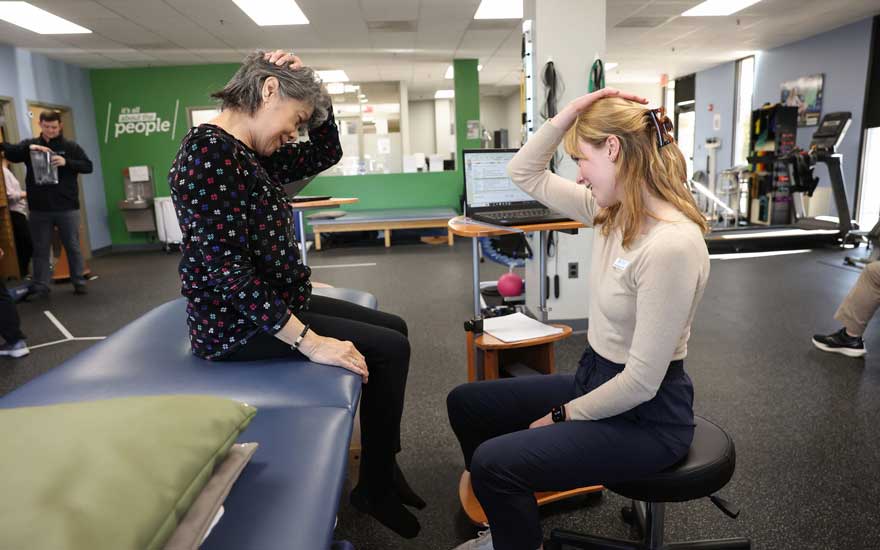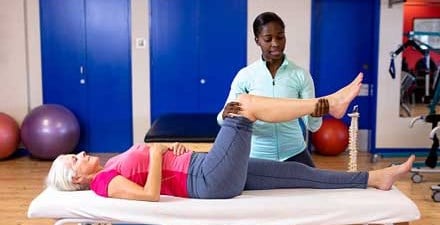Physical Therapy Guide to Osteoarthritis
Arthritis describes inflammation or swelling of joints. Osteoarthritis, or OA, is the most common type of arthritis damaging the joint surfaces. OA impacts the entire joint, including the bones and joints that bear weight, like the hips and knees, are the most often affected. Damage from OA can slowly worsen over time, leading to pain, stiffness, and swelling.
According to the Centers for Disease Control and Prevention, over 32 million Americans have some form of OA. The condition affects women more than men, and the risk of developing OA increases with age. Other risk factors include past joint injury and obesity.
Nearly half of Americans with arthritis report that it limits their activities. OA can affect many things, including:
- Working.
- Walking and climbing stairs.
- Standing up and sitting down.
- Grasping small items.
- Balance.
People with arthritis are four times more likely to have at least two falls. They also are five times more likely to be hurt from falling.
Although a joint replacement is sometimes needed, this is not always the case. You may be able to decrease pain from OA by:
- Safely increasing physical activity (such as walking, biking, swimming).
- Getting stronger.
- Maintaining a healthy weight.
Physical therapists can help people understand and manage their OA. Physical therapy treatments may lessen OA pain and increase strength, motion, and balance. These improvements can positively impact a person's movement function and reduce the chances of falling. Physical therapists can also teach people about healthy lifestyle choices that may positively impact OA.
Physical therapists are movement experts. They improve quality of life through hands-on care, patient education, and prescribed movement. You can contact a physical therapist directly for an evaluation. To find a physical therapist in your area, visit Find a PT.
What Is Osteoarthritis?
Joints, like those in the hip and knee, are where two bones connect to allow motion. Synovial fluid is a "lubricating oil" in joints. Cartilage is a strong, smooth surface that covers and protects the bones at joints. It acts as a "cushion" when bearing weight while standing, walking, and climbing stairs. The cartilage and synovial fluid help reduce friction in the joints for motion. Over time, the protective cartilage can break down. If this happens, a person may have more pain and stiffness when moving.
The cause of OA is not known. Currently, growing older is the main risk factor for developing OA. Factors that may increase your risk for OA include things you can change, such as obesity, and other factors, like age, that we cannot change. Some factors that increase a person's OA risk are:
- Obesity. Extra weight adds more stress to joints that bear weight (such as the hips and knees).
- Age. Cartilage and synovial fluid can break down and worsen over time.
- Sex. Females are at higher risk than males.
- Genetics. Some people have difficulty forming cartilage.
- Past injury.
- Jobs that require repeated and or prolonged squatting, bending, kneeling, and twisting.
How Does It Feel?
Typically, OA causes pain and stiffness in the affected joint. Common symptoms are:
- Joint stiffness first thing in the morning or after sitting or lying down for a little while.
- Joint stiffness that may get better after gently moving the joint.
- Pain or aching during activity that may ease with rest.
- Cracking, creaking, crunching, or clicking sounds while moving the joint.
- Tenderness when pressing around the joint.
- Joint swelling.
- Increased bone growth ("bumps") around the joint.
Caution: Warmth with swelling or redness around the joint is not typical with OA. It may indicate a different condition or signs of inflammation. Please consult your doctor if you have swelling, redness, and warmth in or around a joint.
How Is It Diagnosed?
Physicians and some physical therapists may diagnose osteoarthritis with an X-ray. Some signs that may lead your physical therapist to suspect OA include:
- Joint stiffness.
- Difficulty moving.
- Joint cracking, creaking, or crunching.
- Pain that is relieved with rest.
Physical therapists using the 2022 National Institute for Health and Critical Excellence criteria may consider an OA diagnosis if you are 45 years or older and have joint pain with activity but no stiffness in the morning, or have morning stiffness lasting 30 minutes or less.
How Can a Physical Therapist Help?

Physical therapy can be effective for OA. Physical therapy may help you avoid surgery and prescription pain medications. Although the symptoms of OA are different for each person, starting a targeted exercise program designed by a physical therapist may improve your symptoms and slow the impact OA has on your bones and joints.
Your physical therapist will:
- Perform a thorough exam.
- Observe what activities are difficult for you.
- Design an exercise program to address your specific needs to improve your movement and function.
- Use manual (hands-on) therapy to improve motion in the affected joint(s).
- Suggest ways to adjust your work area to lessen the strain on your joints.
- Teach you how to safely do aerobic and strengthening exercises to improve your movement and overall health.
- Design and teach you an exercise program that you can do at home to maintain and improve your strength and movement after physical therapy.
- Recommend a cane, walker, or knee brace if needed.
- Discuss strategies and teach you exercises for safe weight loss to ease pressure on your joints if needed.
- Recommend lifestyle changes that will help you maintain a healthier weight.
In cases of OA that are not helped by physical therapy alone, your physical therapist will refer you to an orthopedist or orthopedic surgeon to discuss other options. This may include medication, steroid shots, and even surgery in some cases.
Can This Injury or Condition Be Prevented?
Osteoarthritis is more common in older adults. It cannot be prevented entirely. Choosing an active, healthy lifestyle can help slow the onset or progression of OA.
This means maintaining a healthy weight and staying physically active. Taking part in a community exercise class can help you get the recommended amount of regular physical activity.
People who perform repeated movements that stress specific joints during work or sports can benefit from a physical therapist's advice on proper movement techniques and muscle strengthening. This can lessen joint strain and promote joint health.
Everyone, especially older adults, should learn proper balance and movement techniques. This can lower their chances of falling and injuring a joint.
What Kind of Physical Therapist Do I Need?
All physical therapists are prepared through education and experience to treat OA. However, you may want to consider:
- A physical therapist who is a board-certified clinical specialist or who has completed a residency or fellowship in orthopedic or geriatric physical therapy. This physical therapist has advanced expertise and experience that may help treat your OA.
- A physical therapist who specializes in the treatment of OA.
You can find physical therapists with these and other credentials by using Find a PT, a tool built by the American Physical Therapy Association to help you search for physical therapists in your area.
General tips when you're looking for a physical therapist (or any other health care provider):
- Get recommendations from family, friends, or other health care providers.
- Ask about the physical therapists' experience in helping people with osteoarthritis when making an appointment.
- Be prepared to describe your symptoms in as much detail as possible and say what makes your symptoms better or worse.
More Information on Osteoarthritis
- Osteoarthritis of the Hip
- Osteoarthritis of the Knee
- Osteoarthritis of the Shoulder
- Osteoarthritis of the Spine
Other Arthritis Resources
The American Physical Therapy Association believes that consumers should have access to information that can:
- Help them make health care decisions.
- Prepare them for a visit with their health care provider.
The following articles offer some of the best scientific evidence for the treatment of osteoarthritis. The articles report recent research and give an overview of the standards of practice in the United States and internationally. The article titles link either to a PubMed* abstract of the article or to the free full text to read or bring with you to your health care provider.
Dhillon, J., Kraeutler, M. J., Belk, J. W., Scillia, A. J., McCarty, E. C., Ansah-Twum, J. K., & McCulloch, P. C. (2023). Effects of running on the development of knee osteoarthritis: An updated systematic review at short-term follow-up. Orthopaedic Journal of Sports Medicine, 11(3), 1–6. Article Summary in PubMed.
Lo GH, Vinod S, Richard MJ, et al. Association Between Walking for Exercise and Symptomatic and Structural Progression in Individuals With Knee Osteoarthritis: Data From the Osteoarthritis Initiative Cohort. Arthritis Rheumatol. 2022;74(10):1660-1667. Article Summary in PubMed.
Osteoarthritis in over 16s: diagnosis and management. London: National Institute for Health and Care Excellence (NICE); October 19, 2022. Article Summary in PubMed.
American Academy of Orthopaedic Surgeons. Management of osteoarthritis of the knee (non-arthroplasty): Evidence-based clinical practice guideline. Published August 31, 2021. https://www.aaos.org/globalassets/quality-and-practice-resources/osteoarthritis-of-the-knee/oak3cpg.pdf
Izquierdo M, Merchant RA, Morley JE, et al. International Exercise Recommendations in Older Adults (ICFSR): Expert Consensus Guidelines. J Nutr Health Aging. 2021;25(7):824-853. Article Summary in PubMed.
Theis KA, Murphy LB, Guglielmo D, et al. Prevalence of Arthritis and Arthritis-Attributable Activity Limitation - United States, 2016-2018. MMWR Morb Mortal Wkly Rep. 2021;70(40):1401-1407. Published 2021 Oct 8. Article Summary in PubMed.
Kolasinski SL, Neogi T, Hochberg MC, et al. 2019 American College of Rheumatology/Arthritis Foundation Guideline for the Management of Osteoarthritis of the Hand, Hip, and Knee [published correction appears in Arthritis Rheumatol. 2021 May;73(5):799]. Arthritis Rheumatol. 2020;72(2):220-233. Article Summary in PubMed.
Powell KE, King AC, Buchner DM, et al. The Scientific Foundation for the Physical Activity Guidelines for Americans, 2nd Edition. J Phys Act Health. Published online December 17, 2018. Article Summary in PubMed.
Hootman, J. M., Helmick, C. G., Barbour, K. E., Theis, K. A., & Boring, M. A. (2016). Updated projected prevalence of self-reported doctor-diagnosed arthritis and arthritis-attributable activity limitation among US adults, 2015–2040. Arthritis and Rheumatology, 68(7), 1582–1587. Article Summary in PubMed.
Esser S, Bailey A. Effects of exercise and physical activity on knee osteoarthritis. Curr Pain Headache Rep. 2011;15(6):423–430. Article Summary on PubMed.
Urquhart DM, Tobing JF, Hanna FS, et al. What is the effect of physical activity on the knee joint? A systematic review. Med Sci Sports Exerc. 2011;43(3):432–442. Article Summary in PubMed.
Cibulka MT, White DM, Woehrle J, et al. Hip pain and mobility deficits—hip osteoarthritis: clinical practice guidelines linked to the International Classification of Functioning, Disability, and Health from the Orthopaedic Section of the American Physical Therapy Association. J Orthop Sports Phys Ther. 2009;39:A1–A25. Article Summary in PubMed.
*PubMed is a free online resource developed by the National Center for Biotechnology Information. PubMed contains millions of citations to biomedical literature, including citations in the National Library of Medicine's MEDLINE database.
Expert Review:
Sep 12, 2023
Revised:
Mar 1, 2024
Content Type: Guide
Osteoarthritis
PT, DPT, MS
Mike Richardson
PT, DPT, DHSc, Board-Certified Clinical Specialist in Geriatric Physical Therapy
Kenneth L. Miller
PT, DPT, MA, Board-Certified Clinical Specialist in Geratric Physical Therapy, on behalf of APTA Geriatrics
You Might Also Like...
Article
1 in 5 American Adults Are Living With ArthritisMar 4, 2024
Around 53 million American adults are living with arthritis, a leading cause of activity limitations, disability, and chronic pain. Regular physical activity
Health Tips
5 Ways to Help Manage OsteoarthritisOct 17, 2023
Osteoarthritis, or OA, is a degenerative joint disease that causes pain and stiffness and can lead to limited function. Knee OA is the most common type.
Video
Physical Therapy Gets Retired Teacher Playing Piano AgainOct 23, 2019
Linda loved playing the piano, but the effects of arthritis, carpal tunnel syndrome, and surgeries made it difficult for her play. With the help of physical

